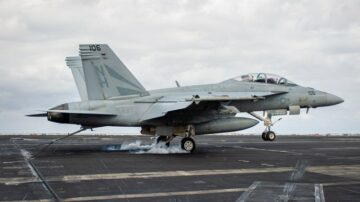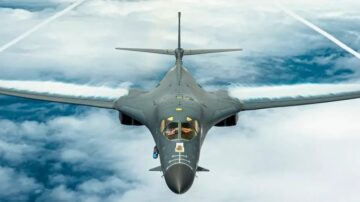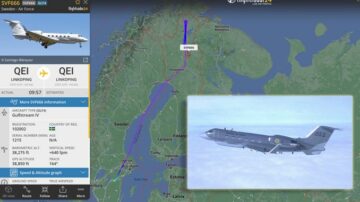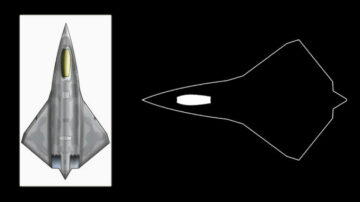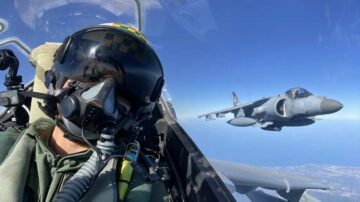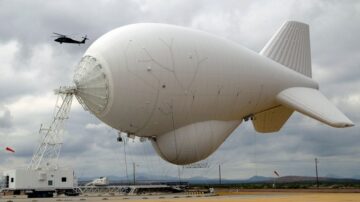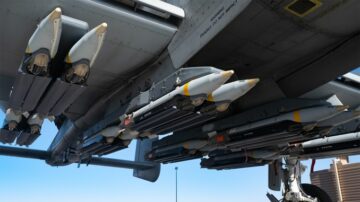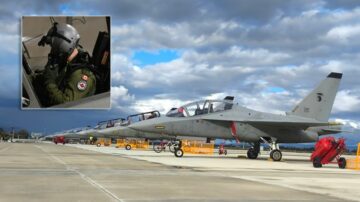
A four-engine flame out sent a B-52H Stratofortress into an uncontrolled left roll. The crew was able to recover the aircraft when the bomber was dangerously close to the ground.
A B-52H Stratofortress bomber crew recently received the Air Force Global Strike Command General Curtis E. LeMay award for outstanding performance in the bomber crew category during the 2023 AFGSC Operations Awards.
On December 13, 2022, the crew were aboard SCOUT 94, when the bomber, flying from Nellis Air Force Base, Nevada, to Barksdale Air Force Base, Louisiana, encountered what an official 2nd Bomb Wing Public Affairs release calls a life-threatening scenario.
The crew comprised Capt. Charles Powell, 11th Bomb Squadron aircraft commander, now serving as Director of Staff; Lt. Col. John Conway, 11th Bomb Squadron radar navigator, currently holding the position of Air Combat Command Training Support Squadron Detachment 13 commander; and Capt. Matthew Walls, 343 Bomb Squadron copilot, now unit deployment manager.
During descent to prepare for landing and while avoiding severe thunderstorms, two of the aircraft’s electrical generators malfunctioned. Suddenly, the aircraft entered an uncontrolled left roll, descending rapidly and decelerating below normal approach speed.
“The emergency was abrupt and disorienting for myself and my fellow crew members,” stated Walls. “All systems shut down simultaneously, plunging the aircraft into darkness, engines flamed out, and regaining control became a struggle.”
The crew promptly initiated troubleshooting procedures to solve the emergency.
“As we lost altitude, Captain Powell directed the restart of engines, informing me that we had lost four engines on one side,” recalled Conway.
Losing all the engines on one side results in an imbalance of thrust across the wings, causing the aircraft to yaw, or turn, towards the side opposite of the functioning engines. The degree of yaw depends on factors such as airspeed, altitude, and the aircraft’s aerodynamic characteristics. Consider that the wingspan of a B-52H Stratofortress is approximately 185 feet (56.4 meters): losing all of a sudden all the thrust on one side while the other continue to provide significant thrust may induce significant angular momentum.
The cockpit of a B-52H (U.S. Air Force photo/Greg L. Davis)
” data-medium-file=”https://i0.wp.com/theaviationist.com/wp-content/uploads/2024/05/B-52H-cockpit-scaled.jpeg?fit=460%2C307&ssl=1″ data-large-file=”https://i0.wp.com/theaviationist.com/wp-content/uploads/2024/05/B-52H-cockpit-scaled.jpeg?fit=706%2C471&ssl=1″ class=”size-large wp-image-85911″ src=”https://platoaistream.net/wp-content/uploads/2024/06/b-52-crew-receive-award-for-heroic-recovery-at-1200-feet-after-uncontrolled-left-roll-and-dive-1.jpg” alt width=”706″ height=”471″ srcset=”https://platoaistream.net/wp-content/uploads/2024/06/b-52-crew-receive-award-for-heroic-recovery-at-1200-feet-after-uncontrolled-left-roll-and-dive-4.jpg 706w, https://platoaistream.net/wp-content/uploads/2024/06/b-52-crew-receive-award-for-heroic-recovery-at-1200-feet-after-uncontrolled-left-roll-and-dive-5.jpg 460w, https://platoaistream.net/wp-content/uploads/2024/06/b-52-crew-receive-award-for-heroic-recovery-at-1200-feet-after-uncontrolled-left-roll-and-dive-6.jpg 128w, https://platoaistream.net/wp-content/uploads/2024/06/b-52-crew-receive-award-for-heroic-recovery-at-1200-feet-after-uncontrolled-left-roll-and-dive-7.jpg 768w, https://platoaistream.net/wp-content/uploads/2024/06/b-52-crew-receive-award-for-heroic-recovery-at-1200-feet-after-uncontrolled-left-roll-and-dive-8.jpg 1536w, https://i0.wp.com/theaviationist.com/wp-content/uploads/2024/05/B-52H-cockpit-scaled.jpeg?resize=2048%2C1365&ssl=1 2048w” sizes=”(max-width: 706px) 100vw, 706px” data-recalc-dims=”1″>
Approximately three minutes into the emergency, Powell successfully restarted engines three and four, easing the asymmetrical load on the aircraft. Declaring an emergency with the ATC (Air Traffic Control), the crew executed a non-standard right turn to evade adverse weather conditions, navigating towards a safe landing.
“I was fortunate to have a proficient crew that allowed me to focus solely on flying the jet,” remarked Powell.
The crew traded altitude for airspeed, regaining control just as the aircraft descended to a precarious altitude of 1,200 feet above ground level in the proximity of Bossier City, Louisiana.
“I attribute Captain Powell’s successful recovery of the aircraft to his extensive training in handling such emergencies and his unwavering commitment to excellence,” asserted Conway. “This enabled him to instinctively adjust the throttle, avoiding exacerbating the asymmetrical situation.”
Approaching runway 15, the crew executed a six-engine landing amidst the daunting challenges they encountered.
2nd Bomb Wing Airmen perform post-flight maintenance on a B-52 Stratofortress after the aircrew and aircraft returned Nov. 14, 2023 to Barksdale Air Force Base, La.
” data-medium-file=”https://i0.wp.com/theaviationist.com/wp-content/uploads/2023/12/Air_Force_B-52_Spare_Parts_1.jpg?fit=460%2C257&ssl=1″ data-large-file=”https://i0.wp.com/theaviationist.com/wp-content/uploads/2023/12/Air_Force_B-52_Spare_Parts_1.jpg?fit=706%2C394&ssl=1″ class=”size-large wp-image-84320″ src=”https://platoaistream.net/wp-content/uploads/2024/06/b-52-crew-receive-award-for-heroic-recovery-at-1200-feet-after-uncontrolled-left-roll-and-dive-2.jpg” alt=”B-52″ width=”706″ height=”394″ srcset=”https://platoaistream.net/wp-content/uploads/2024/06/b-52-crew-receive-award-for-heroic-recovery-at-1200-feet-after-uncontrolled-left-roll-and-dive-2.jpg 706w, https://platoaistream.net/wp-content/uploads/2024/06/b-52-crew-receive-award-for-heroic-recovery-at-1200-feet-after-uncontrolled-left-roll-and-dive-9.jpg 460w, https://platoaistream.net/wp-content/uploads/2024/06/b-52-crew-receive-award-for-heroic-recovery-at-1200-feet-after-uncontrolled-left-roll-and-dive-10.jpg 128w, https://platoaistream.net/wp-content/uploads/2024/06/b-52-crew-receive-award-for-heroic-recovery-at-1200-feet-after-uncontrolled-left-roll-and-dive-11.jpg 768w, https://i0.wp.com/theaviationist.com/wp-content/uploads/2023/12/Air_Force_B-52_Spare_Parts_1.jpg?w=1024&ssl=1 1024w” sizes=”(max-width: 706px) 100vw, 706px” data-recalc-dims=”1″>
While a 6-engine approach might seem just a walk in the park when you have 8 at your disposal, flying an approach of such a large aircraft with asymmetrical thrust and possibly in bad weather conditions isn’t that easy.
According to the Air Force, the exemplary airmanship of the crew of SCOUT 94 directly contributed to the safe recovery of the $84 million aircraft and the preservation of the three-person crew’s well-being, preventing potential catastrophe in the metropolitan area.
“Captains Powell and Walls demonstrated remarkable poise and effectiveness during the ordeal,” praised Conway. “They promptly responded to the crisis, followed correct protocols, and relied on their training.”
“The SCOUT 94 crew overcame multiple catastrophic failures to safely land the aircraft, averting potential disaster in the air and on the ground,” says the official press release.
“I’m immensely proud of our handling of the situation,” expressed Walls. “It demanded swift and decisive action, leaving no room for deliberation. In my opinion, each member fulfilled their role impeccably, doing what was necessary.”
B-52 safety record
The B-52 has a notable safety record considering its extensive operational history spanning several decades. While there have been accidents and incidents involving B-52 aircraft over the years, the overall safety record of the aircraft is generally regarded as favorable, especially when considering its age and the demanding nature of its missions.
The last serious incident occurred on May 19, 2016 when B-52H aircraft (registration number 60-0047) belonging to the 69th Bomb Squadron, 5th Bomb Wing, stationed at Minot Air Force Base in North Dakota, was involved in a runway overrun incident at Andersen Air Force Base in Guam. The aircraft attempted to take off but encountered birds flying over the runway, leading to indications of reduced power from the four engines on the right wing, believed to be caused by bird ingestion.
In response, the crew initiated an aborted takeoff procedure, including reducing engine power, deploying air brakes, and activating the drag parachute. However, the drag parachute failed to inflate properly, and despite the crew’s efforts, the aircraft was unable to stop in time, overrunning the paved surface of the runway by approximately 300 feet (91 meters) with 2,500 feet (760 meters) of runway remaining.
Fortunately, all crew members evacuated safely and received treatment for minor injuries. Tragically, the aircraft sustained significant damage and was completely consumed by fire, resulting in a loss estimated at $112 million.
Previously, on Jul. 21, 2008, a U.S Stratofortress belonging to the 20th Bomb Squadron from Barksdale AFB, Louisiana, callsign “Raidr 21” crashed while taking part in the flyover for the U.S. liberation of the island from Japanese occupation in 1944. The aircraft crashed into the Pacific Ocean approximately 30 nautical miles (56 km) northwest of Apra Harbor, Guam, 5 minutes before the scheduled flyover time, killing the 6 crew members.
The cause of the crash was a wrong horizontal stabilizer trim setting.
The aircraft was on a four-month tour to the Pacific to replace the B-2 Spirit bombers which had been grounded following the loss of one of them on the same base in February 2008.
Anyway, throughout the years, the venerable B-52, affectionately known as the BUFF (“Big Ugly Fat Fellow”), has undergone numerous upgrades and modifications throughout its service life to enhance safety, reliability, and performance.
The aircraft is poised to undergo its most extensive modernization program to date. The U.S. Air Force is gearing up to complete integration efforts and roll out the first batch of upgraded Stratofortress bombers, designated the B-52J, within the 2026-2027 timeframe, aiming for initial operational capability by 2030. Central to this overhaul is the adoption of new RR F130 engines, a replacement for the long-serving Pratt & Whitney TF33-PW-103s utilized since the 1960s. This engine upgrade promises to extend the B-52’s operational lifespan until at least 2050, potentially stretching it to 2060, delivering enhanced fuel efficiency, extended range, reduced emissions of unburned hydrocarbons, and notably lower maintenance expenses.
Among the notable enhancements is the integration of a new radar system, derived from the F/A-18E/F Super Hornet’s APG-79 AESA radar. This advanced radar configuration will significantly boost the B-52’s radar range and situational awareness capabilities while occupying less space than the older mechanically scanned radar, allowing for the inclusion of electronic warfare functionalities.
The adoption of the APG-79 radar brings a host of benefits, including enhanced radar range and situational awareness, as well as the ability to seamlessly integrate targeting pods for improved target acquisition and identification.
Externally, the B-52 will feature two conspicuous humps near the wing roots, speculated to house classified equipment, potentially linked to wideband satellite communication systems. Additionally, the aircraft will undergo a visual makeover, with the removal of blisters housing the AN/ASQ-151 Electro-Optical Viewing System, replaced by Litening and Sniper targeting pods mounted under the left wing.
Internally, the B-52’s cockpit will receive a modernization overhaul, including the installation of multifunction digital displays (MFDs), a hybrid mechanical-to-digital throttle system, new data concentrator units, an updated engine fault maintenance recorder, and an upgraded engine air data system. While some analog instruments will remain, one crew member station will be eliminated, reducing the total crew complement to four members from the current five.
- SEO Powered Content & PR Distribution. Get Amplified Today.
- PlatoData.Network Vertical Generative Ai. Empower Yourself. Access Here.
- PlatoAiStream. Web3 Intelligence. Knowledge Amplified. Access Here.
- PlatoESG. Carbon, CleanTech, Energy, Environment, Solar, Waste Management. Access Here.
- PlatoHealth. Biotech and Clinical Trials Intelligence. Access Here.
- Source: https://theaviationist.com/2024/06/07/b-52-crew-heroic-recovery/
- :has
- :is
- $UP
- 1
- 11th
- 125
- 13
- 14
- 15%
- 16
- 185
- 19
- 1996
- 1st
- 2%
- 200
- 2008
- 2016
- 2022
- 2023
- 2024
- 2030
- 2050
- 20th
- 21
- 2nd
- 30
- 300
- 394
- 4
- 5
- 500
- 5th
- 6
- 8
- 9
- 91
- a
- ability
- Able
- above
- accidents
- acquisition
- across
- Action
- activating
- Additionally
- adjust
- Adoption
- advanced
- adverse
- Affairs
- affectionately
- After
- age
- Aiming
- AIR
- Air Force
- aircraft
- All
- allowed
- Allowing
- alt
- altered
- amidst
- an
- analog
- and
- Andersen
- Angular
- approach
- approximately
- AREA
- AS
- asserted
- At
- attempted
- Australia
- avatar
- averting
- aviation
- avoiding
- award
- awards
- awareness
- B-52
- Bad
- base
- based
- BE
- became
- been
- before
- believed
- belonging
- below
- benefits
- bird
- Birds
- blogs
- bomb
- Books
- boost
- Brings
- buff
- but
- by
- Calls
- Callsign
- capabilities
- capability
- catastrophic
- Category
- Cause
- caused
- causing
- central
- challenges
- characteristics
- Charles
- City
- class
- classified
- Close
- Cockpit
- combat
- command
- commitment
- Communication
- communication systems
- Complement
- complete
- completely
- Comprised
- computer
- Computer Engineering
- concentrator
- conditions
- Configuration
- Consider
- considering
- consumed
- continue
- contributed
- control
- copilot
- correct
- covering
- Crash
- Crashed
- credit
- crew
- Crime
- crisis
- Current
- Currently
- Dakota
- damage
- data
- Date
- David
- Davis
- decades
- December
- decisive
- Defense
- Degree
- delivering
- demanded
- demanding
- demonstrated
- depends
- deploying
- deployment
- Derived
- designated
- Despite
- different
- digital
- digitally
- directed
- directly
- Director
- disaster
- displays
- disposal
- dive
- doing
- down
- during
- e
- each
- easing
- easy
- editor
- effectiveness
- efficiency
- efforts
- Electronic
- eliminated
- emergency
- Emissions
- enabled
- Engine
- Engineering
- Engines
- enhance
- enhanced
- enhancements
- entered
- equipment
- especially
- estimated
- Ether (ETH)
- Europe
- evade
- Excellence
- executed
- expenses
- expressed
- extend
- extended
- extensive
- factors
- Failed
- failures
- famous
- Fat
- fault
- favorable
- Feature
- February
- Feet
- fellow
- Fire
- First
- fit
- five
- flying
- Focus
- followed
- following
- For
- Force
- Forces
- format
- Former
- fortunate
- founder
- four
- from
- front
- Fuel
- fuel efficiency
- fulfilled
- functionalities
- functioning
- gearing
- General
- generally
- generators
- Ghost
- Global
- graduate
- greg
- Ground
- grounded
- had
- Handling
- harbor
- Have
- he
- him
- his
- history
- holding
- Horizontal
- host
- House
- housing
- However
- HTTPS
- Hybrid
- Identification
- image
- imbalance
- immensely
- improved
- in
- incident
- incidents
- Including
- inclusion
- indications
- industry
- inflate
- initial
- initiated
- installation
- instruments
- integrate
- integration
- Intelligence
- into
- involved
- involving
- island
- IT
- Italian
- Italy
- ITS
- Japanese
- John
- journalist
- jpeg
- jpg
- june
- just
- killing
- known
- la
- Land
- landing
- large
- Last
- leading
- least
- leaving
- left
- less
- Level
- liberation
- Life
- lifespan
- linked
- load
- losing
- loss
- lost
- Louisiana
- lower
- magazines
- maintenance
- major
- manager
- many
- matthew
- max-width
- May..
- me
- member
- Members
- might
- Military
- million
- minor
- minutes
- missions
- modernization
- Modifications
- Momentum
- monthly
- more
- most
- multiple
- my
- myself
- Nature
- navigating
- Navigator
- Near
- necessary
- NEVADA
- New
- no
- normal
- North
- North Dakota
- notable
- notably
- nov
- now
- number
- numerous
- occupation
- occurred
- ocean
- of
- off
- official
- older
- on
- ONE
- ones
- operational
- Operations
- Opinion
- opposite
- or
- Other
- Others
- our
- out
- outstanding
- over
- overall
- Overhaul
- Pacific
- Pacific Ocean
- Park
- part
- paved
- perform
- performance
- photo
- pilot
- Planes
- plato
- Plato Data Intelligence
- PlatoData
- plunging
- pods
- poised
- position
- possibly
- potential
- potentially
- Powell
- Powell’s
- power
- Praised
- Prepare
- preservation
- press
- Press Release
- preventing
- private
- procedure
- procedures
- Program
- promises
- promptly
- properly
- protocols
- proud
- provide
- public
- radar
- range
- rapidly
- Read
- receive
- received
- recently
- record
- Recover
- recovery
- Reduced
- reducing
- regarded
- Registration
- release
- reliability
- remain
- remaining
- remarkable
- remarked
- removal
- replace
- replaced
- replacement
- Reported
- responded
- response
- restarted
- resulting
- Results
- returned
- right
- Role
- Roll
- rome
- Room
- roots
- runway
- s
- safe
- safely
- Safety
- same
- satellite
- says
- scenario
- scheduled
- Scout
- seamlessly
- seem
- sent
- serious
- service
- serving
- setting
- several
- severe
- shut
- Shut down
- side
- significant
- significantly
- simultaneously
- since
- situation
- solely
- SOLVE
- some
- Space
- spanning
- speed
- spirit
- Staff
- stand
- stated
- station
- Stop
- strike
- Struggle
- successful
- Successfully
- such
- sudden
- Super
- support
- Surface
- sustained
- SWIFT
- Syria
- system
- Systems
- Take
- takeoff
- taking
- Target
- targeting
- than
- that
- The
- their
- Them
- There.
- they
- this
- three
- throughout
- thrust
- time
- timeframe
- to
- Total
- Tour
- towards
- traded
- traffic
- Training
- treatment
- TURN
- two
- u.s.
- U.S. Air Force
- unable
- under
- undergo
- undergone
- unit
- units
- until
- unwavering
- updated
- upgrade
- upgraded
- upgrades
- utilized
- viewing
- visual
- walk
- war
- was
- we
- Weather
- WELL
- were
- What
- when
- which
- while
- will
- Wing
- wings
- with
- within
- world’s
- worldwide
- written
- Wrong
- years
- you
- Your
- zephyrnet


